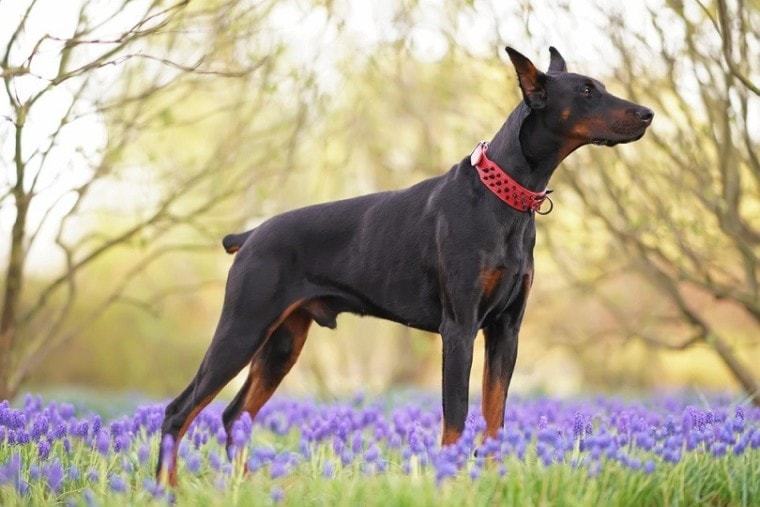
Click Below to Skip Ahead
The Doberman Pinscher is a large, powerful dog bred for its loyalty and intelligence. It was originally bred to be an all-purpose farm guard dog that could fend off wolf attacks on livestock in the late 1800s.
The breed has gone from being one of the most popular breeds in America to less popular since World War II, mainly due to its German heritage. However, with proper care and training, these dogs can make excellent family pets!
Breed Overview
Height:
24 – 28 inches
Weight:
60 – 80 pounds
Lifespan:
10 – 12 years
Colors:
Black, Blue, Brown, Fawn, Red
Suitable for:
Active families, Those with larger living areas
Temperature:
Loyal & Loving, Easy to train, Territorial
Doberman Pinschers are a powerful dog breed with a storied history. They were initially bred for protection and guarding, but they are now often used as police dogs and search-and-rescue dogs. Dobermans do well in obedience trials, flyball races, agility competitions, and Schutzhund (a German word meaning “protection”).
Owning one can be an amazing experience! This article will discuss what a Doberman Pinscher is like and how you should take care of them if you are considering adopting or buying one!
Doberman Pinscher Characteristics
Doberman Pinscher Puppies
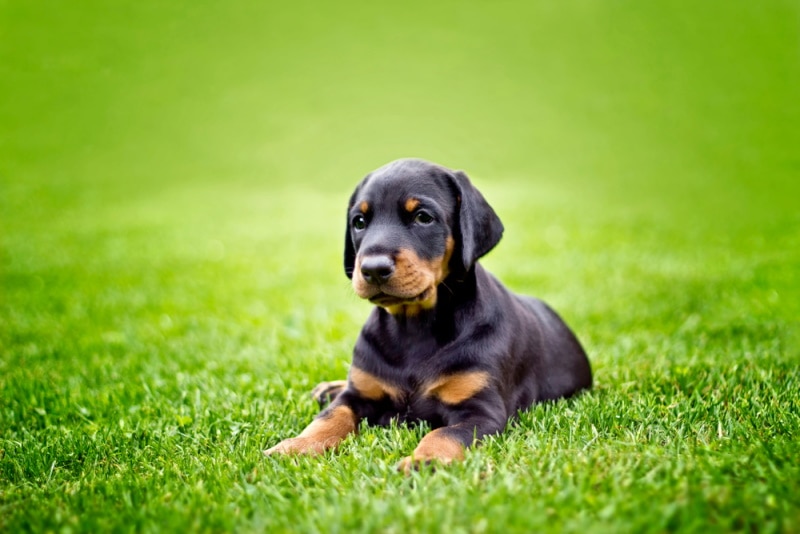
Once you’ve decided you wish to grow your family, it’s time to adopt your Doberman. Make sure to do all the necessary research when looking for a dog breeder. Make sure they let you visit their breeding facilities to make sure they have ethical practices. Meet the puppy’s parents to make sure they’re healthy and to have an idea of the temperament your puppy can have. You may be able to find Doberman Pinscher in a dog shelter but it might not be an easy task.
Be prepared to commit enough time for your Doberman Pinscher, since they require plenty of exercise and mental stimulation to avoid boredom. They are energetic and playful dogs that make great pets and create strong bonds with their families.
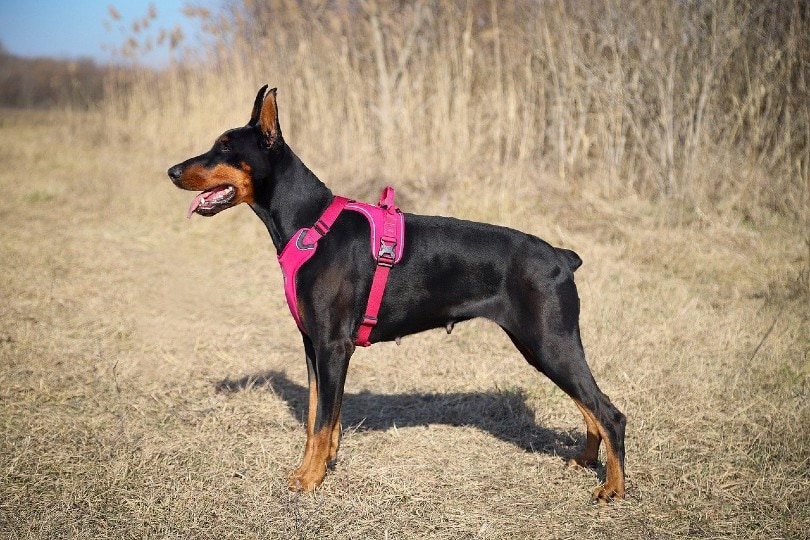
Temperament & Intelligence of the Doberman Pinscher
The Doberman Pinscher is a breed that has incredible intelligence. They can learn and understand their owner’s commands in just two or three repetitions, which means they are effortless to train. Their sharp minds help them when it comes to solving problems and figuring out complex tasks by themselves.
To support this, we can just look at all the armies, police forces, and security services globally that have adopted Doberman Pinschers as their working dogs.
Doberman Pinschers are not just intelligent; they also tend to be affectionate and loving towards people they know well. They are generally pretty confident and calm, which makes them great pets for anyone seeking comfort and security.
Their docile nature is also why many people who need a service animal choose the Doberman Pinscher as their pet. As with any other dog, early socialization is critical to having a well-rounded and happy dog.
Are These Dogs Good for Families? 👪
Due to their calm attitude, Dobermans make superb companions for families and children.
Dobermans are very social animals, which means they need a certain amount of human interaction to be happy. They do not like being left alone with no one at home during the day, as this can lead them to develop separation anxiety.
They also require more exercise than many other breeds – so if you have kids who love running around, your pup will gladly join in, and it will do it some good!
Dobermans are intelligent and obedient. They love to have a job, so they will do anything you ask of them as long as it is done with praise and affection, which comes more often when there are multiple family members.
This breed needs training from an early age to avoid behavioral problems developing later on in life – but you can easily achieve this if you set aside time each day for a training session.
Does This Breed Get Along with Other Pets?
The aforementioned training sessions are the only thing that can guarantee your pet will get along with other animals. Dobermans naturally have a powerful prey drive, so it’s in their nature to chase and kill small animals.
Supervise the first few interactions with other animals closely, but everything should go smoothly if socialized properly!
Pets are drawn to the Doberman Pinscher as well. Cats may be scared of your pet at first, but not for long! If you introduce a new cat slowly, they will get used to one another soon enough.
Other dogs can sometimes pose a problem with this breed. It’s not uncommon for a Doberman to chase smaller dogs, but it doesn’t mean they are attacking. Again, just keep an eye on the interactions and give your pet plenty of space so it doesn’t feel trapped.
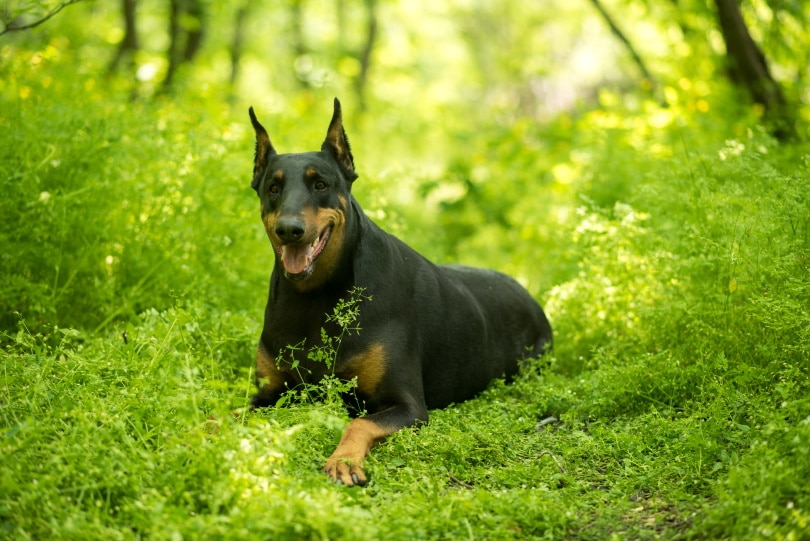
Things to Know When Owning a Doberman Pinscher:
Food & Diet Requirements 🦴
The Doberman is a fairly large and muscular dog, which means they need high-quality food to extend their lifespan.
The breed has a small stomach and can’t eat too much in one sitting, so watch out for overeating! It would be best if you fed your dog about three cups of dry kibble daily or the equivalent in wet food. It’s better to separate this into two or three meals spread out evenly throughout the day.
There are a variety of food brands to choose from, depending on your budget. Whatever you choose, know that Dobermans thrive on a high-protein, high-fiber diet.
Exercise 🐕
Dobermans have a lot of energy inside them, and they need to let it out.
You should plan on walking your dog for at least 45 minutes a day, but the more you do, the better! If you’re really busy or live in an urban area with little space, try going on runs with your pup along sidewalks or urban hiking trails.
They are incredibly athletic, so you can teach them to run alongside you on a bike, and they’ll be able to follow.
Playtime in the backyard or at the dog park is also beneficial for Dobermans who live outside of urban areas and can’t get many walks during the day. Exercise will help keep your pup healthy, happy, and entertained!
Doberman Pinschers are generally well-behaved on walks, but local regulations may require you to put a muzzle on your dog, or the property owner may require it.
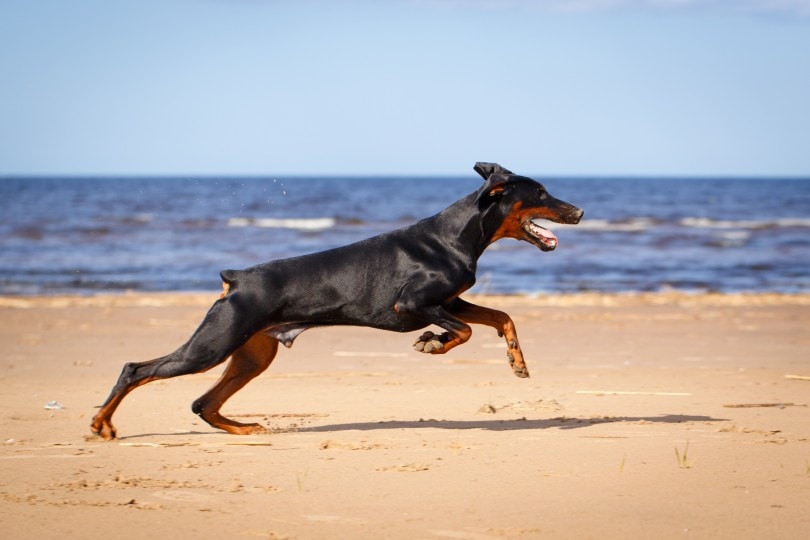
Training 🎾
As one of the most intelligent breeds, Dobermans are eager to learn and respond well when training is consistent.
The trick with training a dog of any size or breed will be consistency!
Their intelligence can make them bored, so they must be given a job or mental stimulation every day to thrive in your home. That’s why they are often used as police dogs or personal protection dogs.
While they may seem tough on the outside, Dobermans do not respond well to scolding and punishment. Instead, opt for positive reinforcement, such as treats and praises, when they do something you want them to do.
During police training, a clicker is often used to denote when the dog has done a good job, which you can then follow with an offering of treats. A well-trained Doberman will be obedient in the show ring or at home with your family.
Grooming ✂️
Dobermans are very easy to groom. To keep their coat sleek and shiny, brush them regularly with a rubber curry comb. Once a week should be enough, but they won’t complain if you turn it into a daily thing!
As for shedding, Dobermans are low shedders for most of the year. However, during spring and summer, they become moderate shedders, so you may want to brush an extra time per week.
Another thing you can do to ensure your pet’s cleanliness is to clean its ears and eyes a few times a month.
Dental health is also very important to every dog breed. You can keep your dog’s teeth clean by brushing them with a toothbrush and some pet-safe, fluoride-free dog toothpaste. You can also use dental chews to keep your four-legged friend’s pearly whites healthy!
As dogs who love the outdoors, you’ll want to clean your Doberman when they return from outside since a dog loves to dig and roll in the dirt!
Health and Conditions 🏥
The word “vet” is enough to make some people cringe, but it’s a good idea to get your pup used to the vet early on, so they don’t have as many fears. Dobermans are prone to certain health conditions that you should never ignore and always look out for.
Some experts say Doberman Pinschers can live for up to 14 years with proper health care, so it’s best not to skimp out on this part.

Serious Conditions:
Big dogs are more prone to conditions such as joint and hip dysplasia, which is a problem of the joints. You’ll notice that your dog has difficulty walking or is favoring one leg over the other.
You’ll also want to keep an eye out for heart disease, which can be a lot of trouble since the symptoms are often very vague and hard to pinpoint. Cardiomyopathy or dilated cardiomyopathy is the most common form of heart disease in Dobermans.
Cardiomyopathy in dogs is defined as a disease of the heart muscle that leads to poor pumping. Untreated, this disease could lead to serious problems like heart failure.
Minor Conditions:
Dobermans may also suffer from minor conditions, such as allergies, leading to itching and hair loss. As with other canines, Doberman eyes are prone to trouble as they age. The most common eye disease in Dobermans is entropion, where the eyelid rolls inward and causes irritation.
Another common eye trouble is dry eye syndrome or keratoconjunctivitis sicca (KCS).
If you see any of these symptoms, consult your veterinarian.
Dobermans also suffer from mental health problems, such as separation anxiety. This is where the dog becomes anxious when left alone or has difficulty being separated from its owner for more than a few hours. The animal may exhibit signs of distress like whining and pacing while awaiting their loved one’s return.
You can mitigate this problem by keeping the dog’s environment as stimulating and engaging as possible so they can entertain themselves while you’re away. You can also adopt another pet to keep them company while you’re away!
Male vs Female
The Doberman is one breed where there are significant differences between males and females of the same species. The female Doberman Pinscher is generally a lot lighter than its male counterpart, sometimes by as much as 20 pounds!
That’s something to consider if you’re planning on cuddling and sleeping with your pet. Females are also slightly less aggressive, although they can still be more protective than most other breeds.
On the other hand, the male tends to be larger and much more muscular, with a personality that combines very strong assertiveness with sensitivity.
One of his greatest assets is also one of his biggest drawbacks- he’ll be very loyal to his loved ones but might aggressively confront a suspicious intruder. At the end of the day, each individual dog has a unique temperament that mostly depends on its upbringing.
3 Little-Known Facts About the Doberman Pinscher
1. Kurt the Doberman Was the First Canine War Hero
Unfortunately for him, he was the first animal casualty of the battle of Guam during World War II. Legend has it he was killed by an exploding grenade that he’d managed to find on the battlefield and tried to bring back to his handler in 1944.
The gesture saved many lives, and he is still commemorated as a hero today, with a statue of him standing tall at his burial site, the United States Marine Corps War Dog Cemetery.
Doberman Pinschers are now recognized as “war dogs” thanks to Kurt’s selfless act.
2. A German Tax Collector engineered the breed
The Doberman Pinscher breed was developed in Germany and is named after Karl Friedrich Louis Doberman, a German tax collector. He created them to protect his belongings from thieves while traveling through dangerous parts of town collecting taxes.
It’s said that these dogs had a strong value system, which made it easy for their trainer to keep them in line. They make for the perfect guard dog because of their intelligence, loyalty, and willingness to please.
3. Breeding is Making Them More Docile
Many people see the image of an angry german dog barking and salivating when they picture a Doberman. Luckily, this is a stereotype.
Breeding has made the Doberman Pinschers so docile they are now commonly used as family pets and service dogs for people with disabilities. The conditions these pets are born in also play a great part in their temperament.
Final Thoughts
If you need a courageous companion for life, the Doberman is the right choice for you. These dogs are big and robust, with an enormous amount of energy to spare.
They’re used extensively by police forces and in many armies worldwide because they can be trained easily, learn fast, and have plenty of intelligence on their side. But these aren’t big bad wolves as some people may think – they’re very gentle beings that just want to please their owner always!
Dobermans are the ideal choice for active people who want to have a dog that can keep up with them in any activity. They’re simply the perfect pet, so we hope you will consider adding one of these incredible dogs into your life!
Related read:
- Male vs Female Dobermans: What Are The Differences?
- Doberman Names: Cool, Tough & Unique Ideas
- Best Toys for Dobermans – Reviews & Top Picks
- Best Shampoos for Doberman Pinschers – Reviews & Top Picks
Featured Image Credit: Eudyptula, Shutterstock








